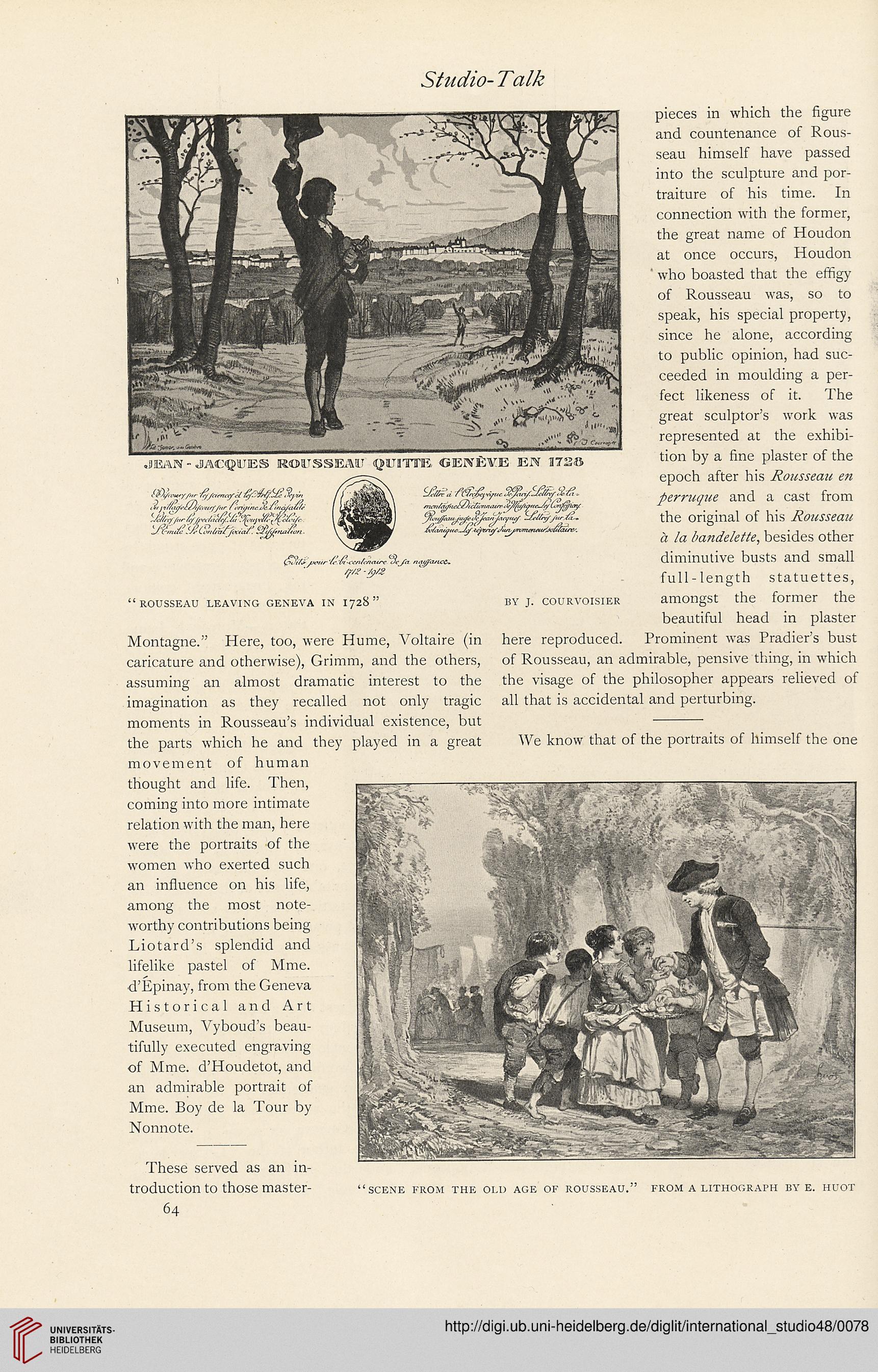Studio-Talk
i
.DiEAN - JACQUES ROUSSEAU QUIITTE, CWfiVE EN 1738
t^)i/<KMf//nr^yaeniyrci Uy it:
' pMlfi'lfy/mirfJi<r O*w<ne.ii /mydiie
Oc-//t>7fiir/tf jrK/ti$?Ja fywiiiX'.&illfr
“ROUSSEAU LEAVING GENEVA IN 1728”
BY J. COURVOISIER
Montagne.” Here, too, were Hume, Voltaire (in
here reproduced.
pieces in which the figure
and countenance of Rous-
seau himself have passed
into the sculpture and por-
traiture of his time. In
connection with the former,
the great name of Houdon
at once occurs, Houdon
' who boasted that the effigy
of Rousseau was, so to
speak, his special property,
since he alone, according
to public opinion, had suc-
ceeded in moulding a per-
fect likeness of it. The
great sculptor’s work was
represented at the exhibi-
tion by a fine plaster of the
epoch after his Rousseau en
perruque and a cast from
the original of his Rousseau
a la bandelette, besides other
diminutive busts and small
full-length statuettes,
amongst the former the
beautiful head in plaster
Prominent was Pradier’s bust
caricature and otherwise), Grimm, and the others,
assuming an almost dramatic interest to the
imagination as they recalled not only tragic
of Rousseau, an admirable, pensive thing, in which
the visage of the philosopher appears relieved of
all that is accidental and perturbing.
moments in Rousseau’s individual existence, but
the parts which he and they played in a great
We know that of the portraits of himself the one
movement of human
thought and life. Then,
coming into more intimate
relation with the man, here
were the portraits of the
women who exerted such
an influence on his life,
among the most note-
worthy contributions being
Liotard’s splendid and
lifelike pastel of Mme.
d’Epinay, from the Geneva
Historical and Art
Museum, Vyboud’s beau-
tifully executed engraving
of Mme. d’Houdetot, and
an admirable portrait of
Mme. Boy de la Tour by
Nonnote.
These served as an in-
troduction to those master-
64
“SCENE FROM THE OLI) AGE OF ROUSSEAU.” FROM A LITHOGRAPH BYE. HUOT
i
.DiEAN - JACQUES ROUSSEAU QUIITTE, CWfiVE EN 1738
t^)i/<KMf//nr^yaeniyrci Uy it:
' pMlfi'lfy/mirfJi<r O*w<ne.ii /mydiie
Oc-//t>7fiir/tf jrK/ti$?Ja fywiiiX'.&illfr
“ROUSSEAU LEAVING GENEVA IN 1728”
BY J. COURVOISIER
Montagne.” Here, too, were Hume, Voltaire (in
here reproduced.
pieces in which the figure
and countenance of Rous-
seau himself have passed
into the sculpture and por-
traiture of his time. In
connection with the former,
the great name of Houdon
at once occurs, Houdon
' who boasted that the effigy
of Rousseau was, so to
speak, his special property,
since he alone, according
to public opinion, had suc-
ceeded in moulding a per-
fect likeness of it. The
great sculptor’s work was
represented at the exhibi-
tion by a fine plaster of the
epoch after his Rousseau en
perruque and a cast from
the original of his Rousseau
a la bandelette, besides other
diminutive busts and small
full-length statuettes,
amongst the former the
beautiful head in plaster
Prominent was Pradier’s bust
caricature and otherwise), Grimm, and the others,
assuming an almost dramatic interest to the
imagination as they recalled not only tragic
of Rousseau, an admirable, pensive thing, in which
the visage of the philosopher appears relieved of
all that is accidental and perturbing.
moments in Rousseau’s individual existence, but
the parts which he and they played in a great
We know that of the portraits of himself the one
movement of human
thought and life. Then,
coming into more intimate
relation with the man, here
were the portraits of the
women who exerted such
an influence on his life,
among the most note-
worthy contributions being
Liotard’s splendid and
lifelike pastel of Mme.
d’Epinay, from the Geneva
Historical and Art
Museum, Vyboud’s beau-
tifully executed engraving
of Mme. d’Houdetot, and
an admirable portrait of
Mme. Boy de la Tour by
Nonnote.
These served as an in-
troduction to those master-
64
“SCENE FROM THE OLI) AGE OF ROUSSEAU.” FROM A LITHOGRAPH BYE. HUOT




